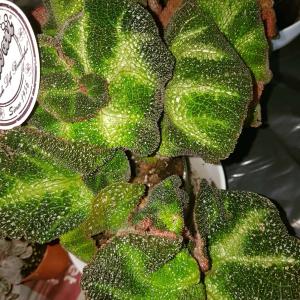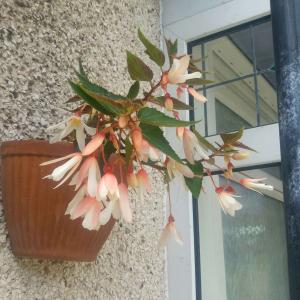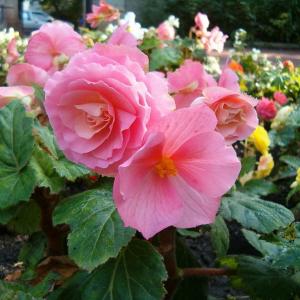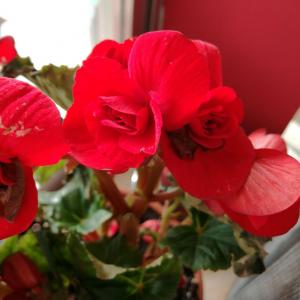文章
Miss Chen
2017年08月15日

Whether a garden is drenched in sun or deep in shade, at least one of the more than 1,000 begonia species (Begonia spp.) and thousands of begonia cultivars can lift it from mundane to magical. As subtropical and tropical plants, most begonias survive winters outdoors in U.S. Department of Agriculture plant hardiness zones 10 through 11. Elsewhere, they can be lifted before the first frost and stored indoors for the winter. Frost isn't their only enemy; the humidity begonias love exposes them to powdery mildew. Treat an infection culturally or organically before resorting to chemical fungicide.

The Fungi
Two powdery mildew fungi (Erysiphe cichoracearum and Oidium begoniae) infect begonias. Wind or water carry their spores to begonia leaves, but they need the right conditions to germinate.
The chances of infection increase when water vapor -- or humidity -- in the air condenses as temperatures drop and dampens the begonias' leaves. Without any moisture, spores landing on the leaves don't germinate. On slightly damp leaves, they germinate in only one hour.
Standing water on the leaves drown the spores. The threat of infection is highest on begonias growing in shade at temperatures fluctuating between 60 and 80 degrees Fahrenheit.
Cultural Treatments
Water begonias in midmorning by sprinkling them from above. Sprinkling removes spores already on the leaves, and drowns the ones landing before the leaves dry.
To lower the humidity around potted begonias, space their pots at least 1 foot apart for good air circulation.

Prune mildewed leaves at the first sign of infection and dispose of them in sealed plastic bags. Remove them with clean, sharp stem cutters rinsed in rubbing alcohol between cuts and after use.
The Milk-and-Water Treatment
A solution of 1 part skim or raw milk to 9 parts water sprayed on infested plants reduces powdery mildew symptoms up to 90 percent, reports the National Gardening Association.
The catch is that the milk-and-water solution won't work on shade-garden begonias. It needs sunlight to trigger its mildew-killing properties, according to researcher Peter Crisp of Australia's Adelaide University.
Spray begonias in sun until the solution coats all their surfaces. Repeat weekly until mildew-favoring conditions subside.
Neem Oil Treatment
Correctly treating begonias with organic, ready-to-use neem oil spray controls powdery mildew without hurting honeybees or other beneficial insects.
Time the treatment for the the early morning or after dark, when bees aren't pollinating. In calm, dry weather with a temperature below 90 degrees Fahrenheit, water the plants well. Dress in protective clothing, including a long-sleeved shirt, long pants, waterproof gloves, a respiratory mask and safety goggles.
Coat the begonias until they drip, being sure to hit the backs of the leaves. Repeat weekly as long as you see symptoms, and then every other week as long as the weather stays dry and temperatures remain between 60 and 80 degrees F.

The Fungi
Two powdery mildew fungi (Erysiphe cichoracearum and Oidium begoniae) infect begonias. Wind or water carry their spores to begonia leaves, but they need the right conditions to germinate.
The chances of infection increase when water vapor -- or humidity -- in the air condenses as temperatures drop and dampens the begonias' leaves. Without any moisture, spores landing on the leaves don't germinate. On slightly damp leaves, they germinate in only one hour.
Standing water on the leaves drown the spores. The threat of infection is highest on begonias growing in shade at temperatures fluctuating between 60 and 80 degrees Fahrenheit.
Cultural Treatments
Water begonias in midmorning by sprinkling them from above. Sprinkling removes spores already on the leaves, and drowns the ones landing before the leaves dry.
To lower the humidity around potted begonias, space their pots at least 1 foot apart for good air circulation.

Prune mildewed leaves at the first sign of infection and dispose of them in sealed plastic bags. Remove them with clean, sharp stem cutters rinsed in rubbing alcohol between cuts and after use.
The Milk-and-Water Treatment
A solution of 1 part skim or raw milk to 9 parts water sprayed on infested plants reduces powdery mildew symptoms up to 90 percent, reports the National Gardening Association.
The catch is that the milk-and-water solution won't work on shade-garden begonias. It needs sunlight to trigger its mildew-killing properties, according to researcher Peter Crisp of Australia's Adelaide University.
Spray begonias in sun until the solution coats all their surfaces. Repeat weekly until mildew-favoring conditions subside.
Neem Oil Treatment
Correctly treating begonias with organic, ready-to-use neem oil spray controls powdery mildew without hurting honeybees or other beneficial insects.
Time the treatment for the the early morning or after dark, when bees aren't pollinating. In calm, dry weather with a temperature below 90 degrees Fahrenheit, water the plants well. Dress in protective clothing, including a long-sleeved shirt, long pants, waterproof gloves, a respiratory mask and safety goggles.
Coat the begonias until they drip, being sure to hit the backs of the leaves. Repeat weekly as long as you see symptoms, and then every other week as long as the weather stays dry and temperatures remain between 60 and 80 degrees F.
0
0
文章
Miss Chen
2017年08月14日

While begonias produce lovely, delicate flowers, they are heat-loving annuals that landscapers depend upon for their toughness. Depending upon your landscape conditions, there is a begonia to fit the bill. Begonias come in many varieties, with light requirements ranging from full sun to heavy shade. In fact, there are over 1,500 named begonia species; this lists focuses on the most popular and readily available varieties. Remember that begonias are annuals, meaning they will not survive freezing temperatures. Unless you live in a tropical climate, you'll need to replant your begonias each year.

Bronze Leaf Begonias
Bronze leaf begonias have a reddish, bronze cast.
With their reddish, bronze-tinted leaves, bronze leaf sempenflorens begonias, also called wax begonias, are striking in appearance and tough in spirit. They can stand up to the summer sun in many parts of the country. However, in some very hot climates, bronze leaf begonias may scorch in full sun. Crispy brown leaf edges are a sign that your begonias need a break from the sun.
Green Leaf Begonias
Green leaf begonias have bright or light green leaves.
Also a sempenflorens or wax variety, green leaf begonias are very similar in appearance to their bronze leaf cousins, but can easily be distinguished by their bright green or light green leaves. While the bronze leaf varieties thrive in full sun, green leaf begonias require shade or dappled shade, with, at most, gentle morning sun. While they bloom no matter how high the temperature rises, they scorch in too much sun. Brown, dried leaf edges will alert you that your green leaf begonias are getting too much sun.

Angel Wing Begonias
Angel wing begonias have leaves that resemble wings.
Angel wing begonias, also called cane begonias or dragon wing begonias, can be identified by their wing-shaped leaves and bamboo-like stems. Angel wing begonias are some of the largest begonias, with cane-like stems that can grow up to 15 feet tall in tropical climates, where they have the opportunity to grow season after season. Angel wing begonias can take full sun in cooler months, but need some shade in hotter months. Growing them in pots allows you to move them throughout the growing season as necessary.
Tuberous Begonias
In general, tuberous begonias produce larger, more-rounded flowers than other types.
Like other types of begonias, tuberous begonias bloom all summer long regardless of the heat. Tuberous begonias do best in bright indirect light, protected from strong direct sunlight that can burn their tender leaves. Tuberous begonias are prized for their larger, rounded flowers. Unlike other begonia species, tuberous begonias grow from tubers, which can be dug up in the fall before the first freeze, stored over the winter and replanted the following spring.

Bronze Leaf Begonias
Bronze leaf begonias have a reddish, bronze cast.
With their reddish, bronze-tinted leaves, bronze leaf sempenflorens begonias, also called wax begonias, are striking in appearance and tough in spirit. They can stand up to the summer sun in many parts of the country. However, in some very hot climates, bronze leaf begonias may scorch in full sun. Crispy brown leaf edges are a sign that your begonias need a break from the sun.
Green Leaf Begonias
Green leaf begonias have bright or light green leaves.
Also a sempenflorens or wax variety, green leaf begonias are very similar in appearance to their bronze leaf cousins, but can easily be distinguished by their bright green or light green leaves. While the bronze leaf varieties thrive in full sun, green leaf begonias require shade or dappled shade, with, at most, gentle morning sun. While they bloom no matter how high the temperature rises, they scorch in too much sun. Brown, dried leaf edges will alert you that your green leaf begonias are getting too much sun.

Angel Wing Begonias
Angel wing begonias have leaves that resemble wings.
Angel wing begonias, also called cane begonias or dragon wing begonias, can be identified by their wing-shaped leaves and bamboo-like stems. Angel wing begonias are some of the largest begonias, with cane-like stems that can grow up to 15 feet tall in tropical climates, where they have the opportunity to grow season after season. Angel wing begonias can take full sun in cooler months, but need some shade in hotter months. Growing them in pots allows you to move them throughout the growing season as necessary.
Tuberous Begonias
In general, tuberous begonias produce larger, more-rounded flowers than other types.
Like other types of begonias, tuberous begonias bloom all summer long regardless of the heat. Tuberous begonias do best in bright indirect light, protected from strong direct sunlight that can burn their tender leaves. Tuberous begonias are prized for their larger, rounded flowers. Unlike other begonia species, tuberous begonias grow from tubers, which can be dug up in the fall before the first freeze, stored over the winter and replanted the following spring.
0
0
文章
Miss Chen
2017年08月14日

Begonias are probably one of the most varied and well-known houseplants. The varieties of begonias number in the thousands, and their popularity is quite apparent. Begonia blooms range from small and delicate to large and roselike. More popular than begonia blooms, the leaves of certain begonia varieties grow into mosaic patterns of varying colors. Several factors cause begonia leaves to fall off suddenly and rot.

Water
The most common reason begonia leaves rot is too frequent watering. Begonias are succulent plants with stems that are mostly water, which makes them very sensitive to moisture and fungus. Overwatering begonias causes their leaves to turn yellow, a process called chlorosis. Eventually, those leaves rot and then fall off. If you see brown spots on the leaves as well, they have the fungal infection botrytis, which thrives in cool and wet conditions.
Temperature and Humidity
Other factors that affect begonia leaves' health are temperature and humidity. Begonias originate from tropical environs and are accustomed to growing in bright, warm and humid conditions. Even if you water your begonia properly, high humidity along with cool temperatures can increase the likelihood that the begonia will suffer from leaf rot and/or botrytis.
Treatment
If your begonia's leaves begin to yellow, all hope is not lost. One of the first ways to stave off chlorosis is to give your begonia a 1/2-strength fertilizer to boost its nutrient intake. If your begonia has yellowing or rotting leaves, another treatment is to change its growing conditions by moving it to a sunnier, warmer place; if a begonia shows signs of chlorosis, it probably is not happy in its location. If your begonia has botrytis spots on its leaves, cut off and dispose of the leaves to avert the fungus' spread.

Prevention
Preventing leaf rot and botrytis requires a few simple measures. When purchasing or planting a begonia, ensure that the potting mixture is light, airy and drains easily; that will prevent the begonia from sitting in water. Plant or buy a begonia in a pot that matches the begonia's size; an oversized pot holds more water in the soil than the begonia can use at one time, resulting in the plant sitting in water. Grow begonias in a sunny or partly sunny location to increase their location's temperature, which will prevent rot and fungus.

Water
The most common reason begonia leaves rot is too frequent watering. Begonias are succulent plants with stems that are mostly water, which makes them very sensitive to moisture and fungus. Overwatering begonias causes their leaves to turn yellow, a process called chlorosis. Eventually, those leaves rot and then fall off. If you see brown spots on the leaves as well, they have the fungal infection botrytis, which thrives in cool and wet conditions.
Temperature and Humidity
Other factors that affect begonia leaves' health are temperature and humidity. Begonias originate from tropical environs and are accustomed to growing in bright, warm and humid conditions. Even if you water your begonia properly, high humidity along with cool temperatures can increase the likelihood that the begonia will suffer from leaf rot and/or botrytis.
Treatment
If your begonia's leaves begin to yellow, all hope is not lost. One of the first ways to stave off chlorosis is to give your begonia a 1/2-strength fertilizer to boost its nutrient intake. If your begonia has yellowing or rotting leaves, another treatment is to change its growing conditions by moving it to a sunnier, warmer place; if a begonia shows signs of chlorosis, it probably is not happy in its location. If your begonia has botrytis spots on its leaves, cut off and dispose of the leaves to avert the fungus' spread.

Prevention
Preventing leaf rot and botrytis requires a few simple measures. When purchasing or planting a begonia, ensure that the potting mixture is light, airy and drains easily; that will prevent the begonia from sitting in water. Plant or buy a begonia in a pot that matches the begonia's size; an oversized pot holds more water in the soil than the begonia can use at one time, resulting in the plant sitting in water. Grow begonias in a sunny or partly sunny location to increase their location's temperature, which will prevent rot and fungus.
1
0
文章
玲儿
2017年07月30日

木立ち性ベゴニアの基本情報
学名:Begonia
その他の名前:キダチベゴニア、コダチベゴニア、木立性ベゴニア
科名 / 属名:シュウカイドウ科 / シュウカイドウ属(ベゴニア属)
特徴
地下に球根や根茎をつくらず、茎が立ち上がるベゴニアを木立ち性ベゴニアと呼んでいます。何段にも枝分かれしたシャンデリアのような花房が、葉の間からいくつも垂れ下がって咲き、花と葉の調和が美しい鉢花です。緑葉のほか、光沢のある黒葉に水玉模様や筋が入るもの、葉の表面にきらきら光る毛が生えてビロードのような質感を呈するものなど、葉の美しい品種が多く、花のない時期でも楽しめます。四季咲き性品種が多く、冬でも夜温を10℃以上に保てば開花し、7℃以上であれば冬越し可能です。
1mを超える大型の品種から、小鉢のまま楽しめる小型の品種もあり、ライフスタイルに合わせて品種を選択することができます。茎をさし木すれば数週間で発根し、容易に株の更新と増殖ができます。
種類(原種、園芸品種)
‘ミセス・ハシモト’
Begonia ‘Mrs. Hashimoto’
白花の大きな花房と緑葉のバランスが美しい。日ざしが強いと花が赤みを帯びるので、半日陰で栽培するとよい。やや病気に弱く、斑点細菌病が出やすい。

‘リッチモンデンシス’
Begonia ‘Richmondensis’
夏の高温と日ざしに強いとともに、よく分枝して茂るので、鉢花としてだけでなく、庭植えもできる。耐寒性もやや強く、暖地であれば軒下で冬越しすることもしばしばある。

‘ジニー’
Begonia ‘Ginny’
花弁も萼片も深い紅色。分枝性がよく、枝が横へ柔らかく伸びるので、ハンギング仕立てに向く。比較的夏越ししやすい。

‘ティー・ローズ’
Begonia ‘Tea Rose’
芳香のある花がよく咲く。日ざしに強く、真夏を除き、日にしっかり当てて育てる。過湿にはやや弱い。

学名:Begonia
その他の名前:キダチベゴニア、コダチベゴニア、木立性ベゴニア
科名 / 属名:シュウカイドウ科 / シュウカイドウ属(ベゴニア属)
特徴
地下に球根や根茎をつくらず、茎が立ち上がるベゴニアを木立ち性ベゴニアと呼んでいます。何段にも枝分かれしたシャンデリアのような花房が、葉の間からいくつも垂れ下がって咲き、花と葉の調和が美しい鉢花です。緑葉のほか、光沢のある黒葉に水玉模様や筋が入るもの、葉の表面にきらきら光る毛が生えてビロードのような質感を呈するものなど、葉の美しい品種が多く、花のない時期でも楽しめます。四季咲き性品種が多く、冬でも夜温を10℃以上に保てば開花し、7℃以上であれば冬越し可能です。
1mを超える大型の品種から、小鉢のまま楽しめる小型の品種もあり、ライフスタイルに合わせて品種を選択することができます。茎をさし木すれば数週間で発根し、容易に株の更新と増殖ができます。
種類(原種、園芸品種)
‘ミセス・ハシモト’
Begonia ‘Mrs. Hashimoto’
白花の大きな花房と緑葉のバランスが美しい。日ざしが強いと花が赤みを帯びるので、半日陰で栽培するとよい。やや病気に弱く、斑点細菌病が出やすい。

‘リッチモンデンシス’
Begonia ‘Richmondensis’
夏の高温と日ざしに強いとともに、よく分枝して茂るので、鉢花としてだけでなく、庭植えもできる。耐寒性もやや強く、暖地であれば軒下で冬越しすることもしばしばある。

‘ジニー’
Begonia ‘Ginny’
花弁も萼片も深い紅色。分枝性がよく、枝が横へ柔らかく伸びるので、ハンギング仕立てに向く。比較的夏越ししやすい。

‘ティー・ローズ’
Begonia ‘Tea Rose’
芳香のある花がよく咲く。日ざしに強く、真夏を除き、日にしっかり当てて育てる。過湿にはやや弱い。

0
0
文章
安静的美女子
2017年05月23日

Check out this list of best flowering houseplants! They can add a bright touch to your home, growing them is similar to other indoor plants.1. Begonia

Although begonias are considered as outdoor plants, there are many plants from begonia genus that makes great flowering houseplants. Most of them are easy to grow and good for beginners. Wax Begonia, Rieger Begonia, and Angel-Wing Begonia are among the best and most popular houseplants.
2. Bromeliads

Its colorful foliage and long lasting flowers can beautify any interior. It thrives easily without much care and the best thing is that you can grow this houseplant in low light conditions too.
3. African violet

African violets are easy to grow flowering plants that can be grown indoors for their beautiful flowers and foliage, they prefer warm climate rather than cold. Keep these plant in a spot where they receive filtered sun.
4. Scented Geranium

Scented geraniums with fragrant leaves and bright colorful flowers become incredible houseplants. However, growing geranium indoors is not as easy as other flowering houseplants we have here in this list. It requires a south or west facing window that receives ample sun and moderate watering.
5. Poinsettia

Growing poinsettias in your home can add a bright touch to your interior. Its multicolor bracts look more colorful than its flowers. This tropical plant requires, light, warmth and protection from drafts to thrive indoors.
6. Peace Lily

If you want to grow a low-care plant, grow peace lily. Inside your home, it can live without water for days. Peace lily’s beautiful white flowers flourish in low lighting conditions. It also removes the toxins from the air.
7. Lipstick Plant

Although not commonly grown as a houseplant, lipstick plant can be grown indoors. It requires constantly warm temperature and humid surrounding to grow and thrive. Here is more on how to grow lipstick plant.
8. Jasmine

Many jasmine varieties can be grown indoors. If you keep this most fragrant vine in a bright spot where it receives some hours of direct sunlight daily, it’ll grow. The selection of jasmine varieties you want to plant indoors depends on the climate you live in. For colder regions, Jasminum polyanthum is the one you can try, whereas in tropics most of the plants from this species will grow.
9. Impatiens
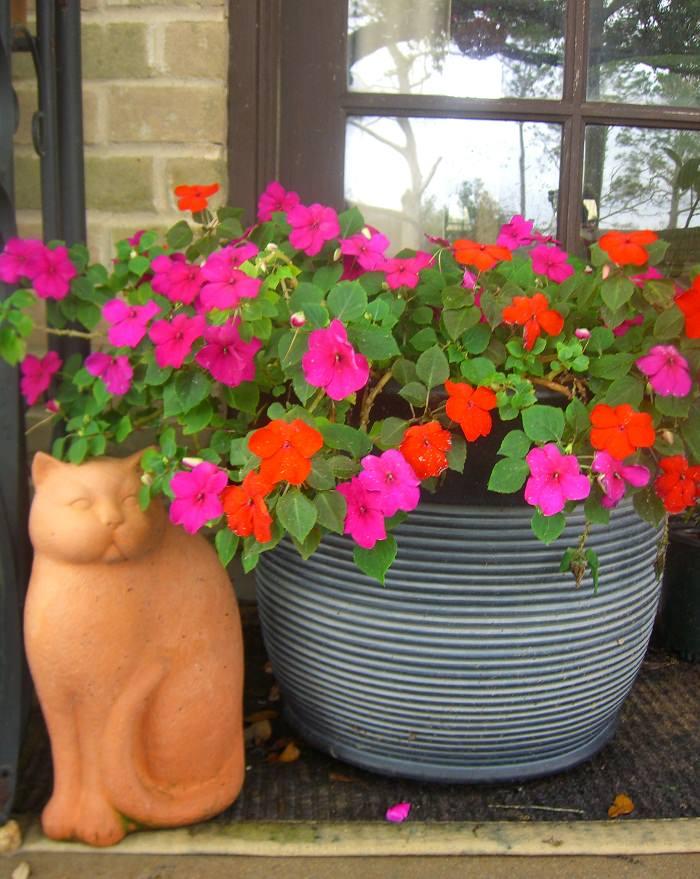
Impatiens are beautiful shade loving annuals but in optimum conditions, you can grow them year-round as a houseplant. Maintain room temperature above 50-55 F and place the pot in a spot that receives bright indirect sun all day long, it would be better if you can provide 1-2 hours of direct sunlight too.
10. Kalanchoe

Kalanchoe is a tropical succulent, plants of this genus grows best outdoors in warm climates. However, it can be grown indoors. This flowering succulent comes in a variety of colors and has low watering needs. You can keep it near a window where it can receive a few hours of sun in order to bloom.
11. Oxalis or Purple Leaf Shamrock

This beautiful flowering houseplant can adorn your house with showy purple foliage and white or pink flowers. Place it at a bright spot for abundant blooms and allow the soil to dry out between watering spells.
12. Cape Primrose

Cape Primrose or “Streptocarpus x hybridus” is a relative of the African violet. If you keep the soil lightly moist and give it bright, indirect sun year-round, it will bloom continuously. Also, there are many new hybrid varieties available with bigger flowers, longer blooming time, and more compact foliage.
13. Christmas Cactus

Christmas cactus is an old-fashioned favorite houseplant of many. When it blooms it creates a warm atmosphere. Red, pink, white or orange: The lovely flowers can quickly brighten up any interior. If maintained well, it can even bloom again from one year to another for years.
Also Read: How to Make Christmas Cactus Bloom at Christmas
14. Crown of Thorns

The Crown of Thorns becomes an exceptional houseplant due to its continuous blooms and low watering needs. If you can provide a sunny window where the plant can be placed, it will grow happily. Available in so many colors, the plant prefers loamy succulent soil and warm temperature.
15. Black Eyed Susan Vine

Black-eyed Susan vine can be grown indoors. Depending on your climate, this annual or perennial flowering plant can add a dramatic appeal to your rooms. Keep it near a window, where it receives a lot of sun.
Also Read: Best Indoor Vines
16. Purple Heart or Inch Plant (Wandering Jew)

A cluster of purple, lance-shaped leaves makes purple heart an impressive houseplant with or without its pink flowers. This beautiful trailing indoor plant can be grown in small colorful pots or hanging baskets and can be used as a table accent. Keep your purple heart (Tradescantia pallida) plant in a spot where it will receive 2-3 hours of sun for a healthy plant.
Note: Several other plants from this genus apart from Tradescantia pallida are known with similar names! For example, Tradescantia zebrina and Tradescantia fluminensis17. Orchids

Orchids are different from other houseplants. Unlike ferns, philodendrons, palms and Swedish ivy, orchids do not grow in soil. Putting an orchid in soil is actually one of the best ways to kill it. You can learn more about growing orchid indoors here.

Although begonias are considered as outdoor plants, there are many plants from begonia genus that makes great flowering houseplants. Most of them are easy to grow and good for beginners. Wax Begonia, Rieger Begonia, and Angel-Wing Begonia are among the best and most popular houseplants.
2. Bromeliads

Its colorful foliage and long lasting flowers can beautify any interior. It thrives easily without much care and the best thing is that you can grow this houseplant in low light conditions too.
3. African violet

African violets are easy to grow flowering plants that can be grown indoors for their beautiful flowers and foliage, they prefer warm climate rather than cold. Keep these plant in a spot where they receive filtered sun.
4. Scented Geranium

Scented geraniums with fragrant leaves and bright colorful flowers become incredible houseplants. However, growing geranium indoors is not as easy as other flowering houseplants we have here in this list. It requires a south or west facing window that receives ample sun and moderate watering.
5. Poinsettia

Growing poinsettias in your home can add a bright touch to your interior. Its multicolor bracts look more colorful than its flowers. This tropical plant requires, light, warmth and protection from drafts to thrive indoors.
6. Peace Lily

If you want to grow a low-care plant, grow peace lily. Inside your home, it can live without water for days. Peace lily’s beautiful white flowers flourish in low lighting conditions. It also removes the toxins from the air.
7. Lipstick Plant

Although not commonly grown as a houseplant, lipstick plant can be grown indoors. It requires constantly warm temperature and humid surrounding to grow and thrive. Here is more on how to grow lipstick plant.
8. Jasmine

Many jasmine varieties can be grown indoors. If you keep this most fragrant vine in a bright spot where it receives some hours of direct sunlight daily, it’ll grow. The selection of jasmine varieties you want to plant indoors depends on the climate you live in. For colder regions, Jasminum polyanthum is the one you can try, whereas in tropics most of the plants from this species will grow.
9. Impatiens

Impatiens are beautiful shade loving annuals but in optimum conditions, you can grow them year-round as a houseplant. Maintain room temperature above 50-55 F and place the pot in a spot that receives bright indirect sun all day long, it would be better if you can provide 1-2 hours of direct sunlight too.
10. Kalanchoe

Kalanchoe is a tropical succulent, plants of this genus grows best outdoors in warm climates. However, it can be grown indoors. This flowering succulent comes in a variety of colors and has low watering needs. You can keep it near a window where it can receive a few hours of sun in order to bloom.
11. Oxalis or Purple Leaf Shamrock

This beautiful flowering houseplant can adorn your house with showy purple foliage and white or pink flowers. Place it at a bright spot for abundant blooms and allow the soil to dry out between watering spells.
12. Cape Primrose

Cape Primrose or “Streptocarpus x hybridus” is a relative of the African violet. If you keep the soil lightly moist and give it bright, indirect sun year-round, it will bloom continuously. Also, there are many new hybrid varieties available with bigger flowers, longer blooming time, and more compact foliage.
13. Christmas Cactus

Christmas cactus is an old-fashioned favorite houseplant of many. When it blooms it creates a warm atmosphere. Red, pink, white or orange: The lovely flowers can quickly brighten up any interior. If maintained well, it can even bloom again from one year to another for years.
Also Read: How to Make Christmas Cactus Bloom at Christmas
14. Crown of Thorns

The Crown of Thorns becomes an exceptional houseplant due to its continuous blooms and low watering needs. If you can provide a sunny window where the plant can be placed, it will grow happily. Available in so many colors, the plant prefers loamy succulent soil and warm temperature.
15. Black Eyed Susan Vine

Black-eyed Susan vine can be grown indoors. Depending on your climate, this annual or perennial flowering plant can add a dramatic appeal to your rooms. Keep it near a window, where it receives a lot of sun.
Also Read: Best Indoor Vines
16. Purple Heart or Inch Plant (Wandering Jew)

A cluster of purple, lance-shaped leaves makes purple heart an impressive houseplant with or without its pink flowers. This beautiful trailing indoor plant can be grown in small colorful pots or hanging baskets and can be used as a table accent. Keep your purple heart (Tradescantia pallida) plant in a spot where it will receive 2-3 hours of sun for a healthy plant.
Note: Several other plants from this genus apart from Tradescantia pallida are known with similar names! For example, Tradescantia zebrina and Tradescantia fluminensis17. Orchids

Orchids are different from other houseplants. Unlike ferns, philodendrons, palms and Swedish ivy, orchids do not grow in soil. Putting an orchid in soil is actually one of the best ways to kill it. You can learn more about growing orchid indoors here.
1
2
成长记
Plants Encyclopdias
2016年08月17日
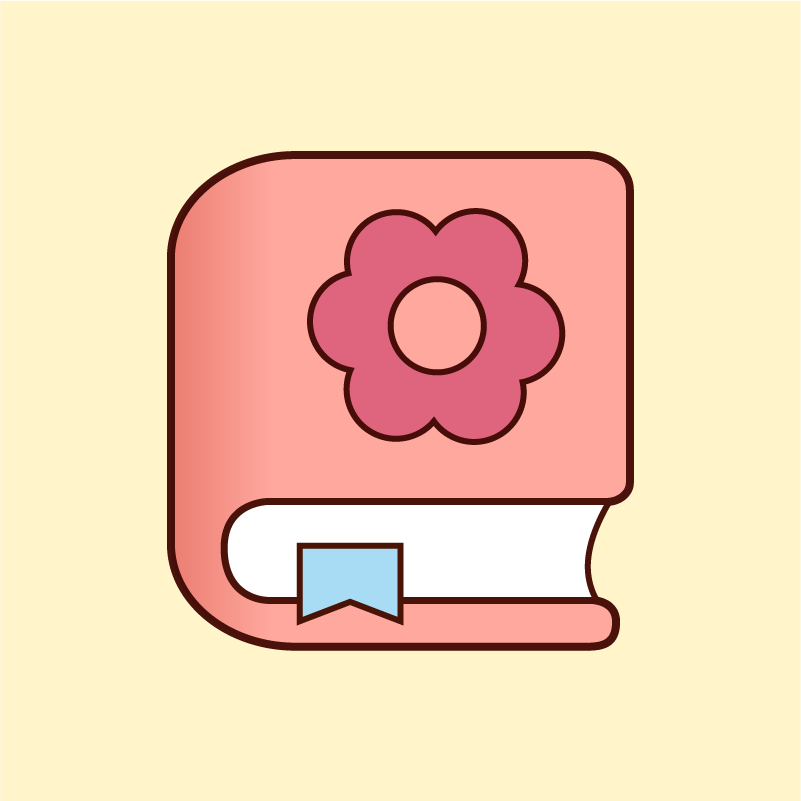
Name: Elatior Begonia
Latin: Begoniaceae Elatior
Origin: Asia
Plant height: 20 - 40 cm
Reproduction: #Stems
Difficulty level: #Easy
Tags: #Asia #BegoniaceaeElatior
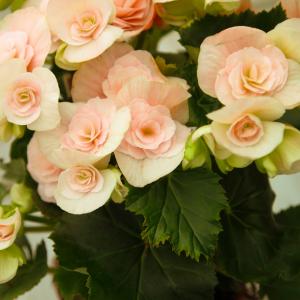
Latin: Begoniaceae Elatior
Origin: Asia
Plant height: 20 - 40 cm
Reproduction: #Stems
Difficulty level: #Easy
Tags: #Asia #BegoniaceaeElatior

1
1
成长记
Plants Encyclopdias
2016年08月17日

Name: Begonia X rex
Latin: Begoniaceae
Origin: Asia
Plant height: 20 - 50 cm
Reproduction: #Stems
Difficulty level: #Easy
Tags: #Asia #Begoniaceae
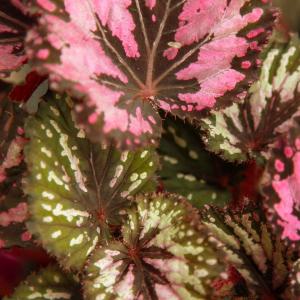
Latin: Begoniaceae
Origin: Asia
Plant height: 20 - 50 cm
Reproduction: #Stems
Difficulty level: #Easy
Tags: #Asia #Begoniaceae

2
1



